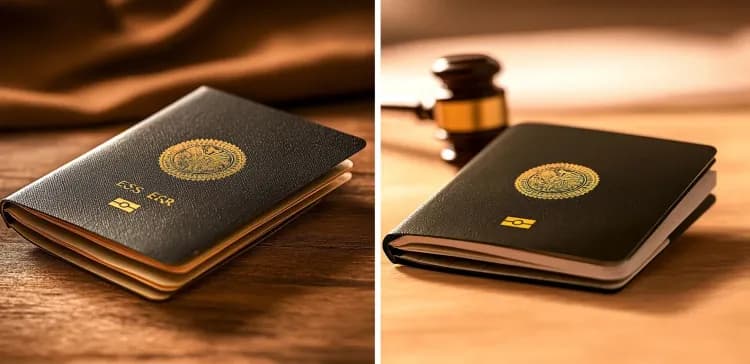ECR vs Non-ECR Passports

Destination (from India)
Dates of Travel (optional)
ECR vs Non-ECR Passports: Understanding the Differences and Implications
When it comes to obtaining an Indian passport, one of the key aspects that often confuse applicants is the distinction between ECR (Emigration Check Required) and Non-ECR (Non-Emigration Check Required) categories.
Understanding the differences between these two can help you make informed decisions, whether you're applying for a passport or planning to travel abroad. Let’s understand the fundamentals of ECR and non-ECR, their significance, and how they affect Indian passport holders.
1. What is ECR?
The ECR (Emigration Check Required) category is primarily designed for Indian passport holders who have not completed their matriculation (10th grade) and are likely to seek employment in certain countries where Indian citizens are often employed in blue-collar jobs. These countries are part of what the Indian government identifies as “ECR countries” and include most Gulf Cooperation Council (GCC) countries, as well as countries in Southeast Asia and Africa.
Why is the ECR Category Important?
The ECR category was established to protect unskilled or semi-skilled workers from exploitation abroad. Before travelling to an ECR country, individuals in this category are required to obtain emigration clearance from the Protector of Emigrants (POE) office. This clearance is a safeguard to ensure that the terms of employment are fair and transparent, and that the individual is fully informed about their rights and the nature of their work.
List of ECR Countries:
As of the latest updates, the list of ECR countries includes:
- United Arab Emirates (UAE)
- Saudi Arabia
- Qatar
- Kuwait
- Oman
- Bahrain
- Malaysia
- Iraq
- Jordan
- Lebanon
- Afghanistan
- Indonesia
- Syria
- Sudan
- Libya
- Thailand
- Yemen
- Maldives
2. What is a Non-ECR Category?
The Non-ECR (Non-Emigration Check Required) category, also known as ECNR (Emigration Check Not Required), is applicable to individuals who meet certain educational or professional criteria, indicating that they do not need emigration clearance to travel for work or other purposes. Typically, this includes individuals who have completed at least matriculation, are income-taxpayers or hold a skilled job.
Who is Eligible for Non-ECR Category?
To be classified under the non-ECR category, applicants generally fall into one of the following categories:
- Individuals who have passed their 10th standard (matriculation) or higher levels of education.
- Government employees and their dependents.
- Income taxpayers, as evidenced by a PAN card or tax returns.
- Professionals like doctors, engineers, lawyers, or those in skilled trades.
- Seafarers who hold Continuous Discharge Certificates.
- Children below 18 years of age.
Non-ECR passport holders do not need to obtain an emigration clearance when travelling to ECR countries, which makes their travel process smoother and quicker. This category is often seen as advantageous, particularly for frequent travellers or professionals working abroad.
4. How to Apply for ECR or Non-ECR Status?
When applying for an Indian passport, the passport application form will ask you to declare your educational qualifications and professional status. Based on this information, the passport office will categorise your passport as either ECR or non-ECR.
Steps to Apply:
1. Fill Out the Passport Application Form: In the application form, you’ll be required to provide details of your educational qualifications. If you meet the criteria for non-ECR, the passport will automatically be issued under this category.
2. Submit Supporting Documents: To obtain a non-ECR passport, you must submit documents like your matriculation certificate, graduation certificate, income tax returns, or professional certifications as proof of your eligibility.
3. Verification Process: The Passport Seva Kendra (PSK) will verify the documents during your appointment. If everything is in order, your passport will be marked as non-ECR.
4. Receiving Your Passport: After successful verification, you will receive your passport. The last page of the passport will indicate whether it is ECR or non-ECR.
5. Can ECR Status be Changed to Non-ECR?
Yes, an individual can change their ECR status to non-ECR if they meet the required qualifications at a later date. This is particularly useful for individuals who may have started working without a matriculation certificate but later completed their education or gained professional qualifications.
Steps to Change ECR to Non-ECR:
1. Obtain the Required Qualifications: Ensure you have completed matriculation or obtained a professional qualification.
2. Apply for Re-issue of Passport: Visit the Passport Seva website and apply for a re-issue of your passport, providing the necessary documents to prove your non-ECR eligibility.
3. Verification and Issue: Your documents will be verified, and upon successful verification, a new passport will be issued with non-ECR status.
6. Implications of ECR and Non-ECR Status
For ECR Passport Holders:
- Travel Restrictions: ECR passport holders face more restrictions when travelling to certain countries for work. They must ensure that their emigration clearance is obtained before departure, which could lead to delays.
- Employment Protections: The mandatory clearance provides an additional layer of protection against exploitative work conditions, ensuring that the individual is aware of their rights and the job terms.
For Non-ECR Passport Holders:
- Ease of Travel: Non-ECR status allows for greater freedom and flexibility in travelling to ECR countries, making it ideal for professionals and frequent travellers.
- No Need for Emigration Clearance: Non-ECR passport holders are exempt from the emigration clearance requirement, simplifying the travel process and reducing the bureaucratic hurdles.
7. Conclusion
Understanding whether you fall into the ECR or non-ECR category is crucial for ensuring a smooth travel experience and for safeguarding your rights when working abroad. If you’re eligible for non-ECR status, it can significantly simplify your travel process, especially if you frequently visit ECR countries for work or leisure. On the other hand, if you’re an ECR passport holder, it’s important to be aware of the necessary steps to obtain emigration clearance and to ensure that your employment abroad is legally and ethically sound.
Whether you’re applying for a passport for the first time or considering an upgrade from ECR to non-ECR, being informed about these categories will help you navigate the process with confidence. Always remember to provide accurate information and supporting documents during your application to avoid any complications during your travel.
FAQ
1. What is the difference between an ECR and Non-ECR passport?
ECR (Emigration Check Required) and Non-ECR (Emigration Check Not Required) are categories in Indian passports that determine whether the passport holder needs emigration clearance to work in certain countries. ECR status requires clearance from the Protector General of Emigrants before travelling to specified countries for employment, primarily to protect low-wage workers from exploitation. Non-ECR status is granted to individuals who meet certain educational or professional criteria, allowing them to travel freely without the need for such clearance.
2. What is Non-ECR category?
The Non-ECR (Emigration Check Not Required) category is for Indian passport holders who do not need to obtain emigration clearance from the government before travelling for work or other purposes to certain countries. Eligibility for non-ECR status typically includes individuals who have completed at least 10th-grade education, income taxpayers, government employees, and professionals like doctors, engineers, and teachers. This status simplifies international travel, especially for employment in countries where emigration checks would otherwise be required.
3. What is ECR category in a passport?
ECR (Emigration Check Required) in an Indian passport indicates that the holder must obtain emigration clearance from the Protector General of Emigrants before travelling to certain countries for employment. This requirement is primarily for individuals with lower educational qualifications or those who may be vulnerable to exploitation abroad. The clearance is intended to ensure that the employment conditions are safe and legally compliant, protecting the worker's rights overseas.
Other topics

